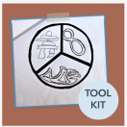Module 6: Digital Scholarship
Engaging with Indigenous Technologies
Diversity and inclusion technology
It is important to be able to provide examples of technology developed for and by Indigenous Peoples. It is important for Indigenous Peoples to see themselves in the technology available.
Learner notes
“Digital environments are not neutral spaces, nor should they be considered landless.”
Examples
Find, choose, and share relevant technologies
When finding, choosing, and sharing a technology with your class or using it to conduct research, ask yourself these questions:
- Whose knowledge system is being enacted?
- Is it Indigenous created and managed?
- What is its purpose?
- Is it viewed through a decolonized lens?
- Does it represent Indigenous education?
- Is it considered Indigenous technology?
- Is the technology an appropriate way of using technology that is culturally relevant?
Learner notes
Share technologies relevant to Indigenous Peoples
Reflect back to Module 5: Technology Supports. In that module, you became familiar with some of the Indigenous-led technology available. Now let’s take a look at how you can utilize and inform others of technologies that are relevant and responsive to Indigenous Peoples and that respect reconciliation.
Professional development
As part of your professional development, we would like to suggest you choose an Indigenous-led technology and take the opportunity to share that information in your professional network.
Department meetings
Share Indigenous-led technology with your colleagues during department and team meetings.
Modelling usage
Modelling Indigenous-led technology in your classroom, research, or in your personal life can support advancing understanding and honouring reconciliation.
Share in circle
If you hold space for circle at the beginning and end of your class, that would be a great time to share or ask others to share their knowledge of Indigenous-led technologies.
Social media
Social media sites can be a great resource to follow Indigenous social media influencers who are knowledgeable about Indigenous-led technologies. Social media is also an avenue for you to post your knowledge. LinkedIn is a source for finding Indigenous cultural safety consultants who may specialize in Indigenous technologies.
Self-Assessment #2
 How can you become an advocate for Indigenous digital literacy by informing others of technologies that are relevant and responsive to Indigenous Peoples?
How can you become an advocate for Indigenous digital literacy by informing others of technologies that are relevant and responsive to Indigenous Peoples?
What have you learned so far in this course that you are excited to research further and share with others?
Record your responses in your Toolkit.
Why incorporate Indigenous technology into your teaching?
Incorporating Indigenous values into educational environments can make education relevant to Indigenous students and give non-Indigenous students opportunities to learn about Indigenous history and culture through an Indigenous perspective.
Learner notes
This is also true of incorporating Indigenous Technologies into your teaching and digital scholarship.
Source and recommended reading: Indigenous Values in Education Benefit Everyone (uvic.ca) [PDF]
This work honours Canada’s commitment to the Truth and Reconciliation Commission in advancing reconciliation and honours Indigenous ways of seeing and being in the world (for more information, refer to Module 1: Ethical and Legal Considerations).
This work meets the educational needs of Indigenous Peoples, and increasing all Canadians’ knowledge of Indigenous values and perspectives is vitally important.
This is important work.
Technology can reach a wider audience and have a positive impact on Indigenous learners and advocates.
Learner notes
Technology and projects with Indigenous communities
We have asked you to intentionally and purposefully use Indigenous digital technologies for learning, teaching, and sharing. This will include developing effective research methods.
You may be wondering where to begin.
For a better understanding of research with Indigenous Peoples, please refer to Module 1: Ethical and Legal Considerations. Here are additional resources that can help you navigate research in a good way:
- Search the Nation’s website
- Review this resource: Building Indigenous-led Engagement Frameworks: Report on the Dialogue on Indigenous Data, Information and Records | University of British Columbia [PDF]

